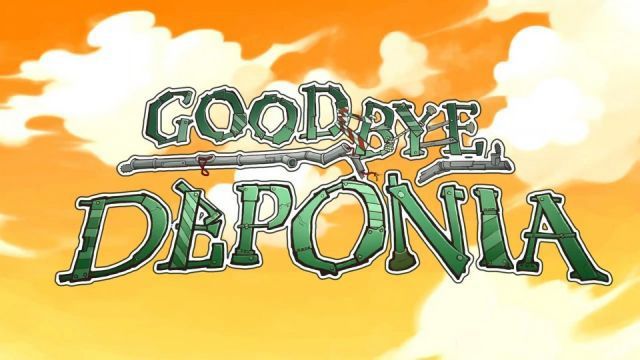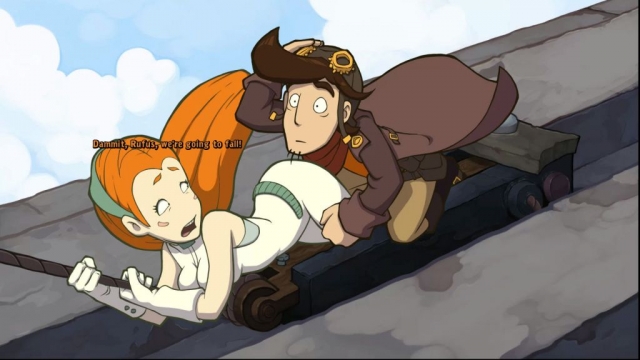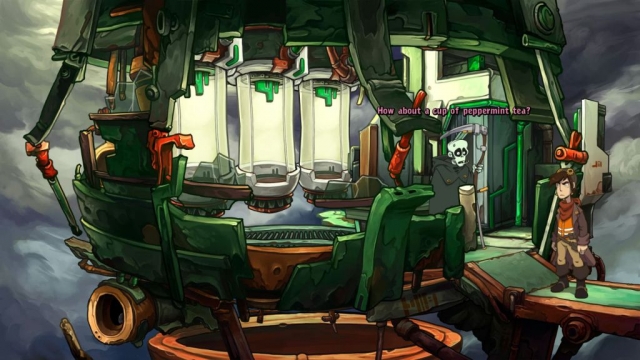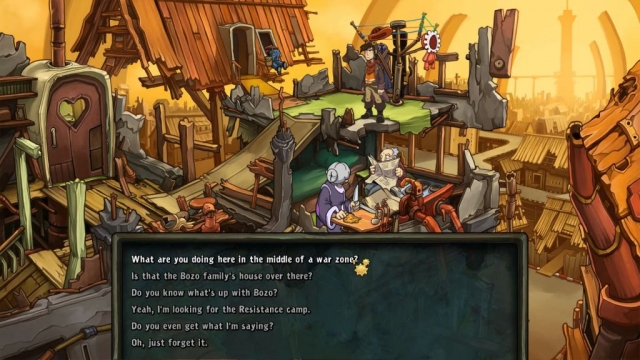Goodbye Deponia

Goodbye Deponia is the third Deponia adventure from Daedalic Entertainment, following in the footsteps of Deponia (2012) and Chaos on Deponia (also 2012). It’s surprising that Daedalic has been able to crank out these games so quickly. With less than a year between each title, you might worry that Daedalic is in cash-grab mode, relying on the name of the franchise to sell copies rather than the quality of the content, but just the opposite is true. For the second sequel in a row, my score has actually gone up, and the series is now funnier than ever.
Goodbye Deponia picks up where Chaos on Deponia left off. You control an anti-hero named Rufus, and you’re still trying to save Deponia from destruction while impressing your would-be girlfriend Goal (just not necessarily in that order). Rufus hasn’t changed at all, which means he’s still an “ends justify the means” sort of guy who comes up with outrageous solutions to each of his problems, but Goal has been put back together (she was split into three parts in the previous game), and now she’s starting to think that there might be something to this Rufus guy after all.
Rufus and Goal start out the game on Deponia, and they spend most of their time at an out-of-the-way hotel and in the city of Porta Frisco, where they encounter a laundry cult, an evil burrito wrap seller, a noose salesman, and more. That is, the game is just as silly as ever, and the writing remains witty and clever, with lots of good one-liners from Rufus. The only downside to the story is that for the third game in a row, your objective is basically the same — to reach Elysium and warn the people there that Deponia is actually inhabited and shouldn’t be blown up. For some reason I was thinking that Goodbye Deponia was going to be the final game of a trilogy, but the ending doesn’t really resolve anything, and it leaves Rufus in dire straits, so I suspect we’re going to see a fourth Deponia title released sometime this summer.
The engine in Goodbye Deponia hasn’t changed since the start of the series, which means it still uses a fairly standard point-and-click interface. You left-click to move Rufus around and perform actions on objects (including picking things up and talking to people), and you right-click to examine things. The mouse wheel opens up your inventory, and the spacebar shows you all of the hotspots for the current scene. Double clicking on an exit immediately moves you to the next scene. If you’ve played any point-and-click adventures during the last ten years, then you should be able to jump into Goodbye Deponia without any trouble, although you might want to play the tutorial anyway, just because it’s funny (and ends up being a Sisyphus-style punishment when Rufus is briefly sent to hell).
The puzzles in Goodbye Deponia include a mixture of inventory-based puzzles, where you pick things up and use them in the right way, and mini-games, where you have to move things around to achieve some sort of goal. As an example of the former, at one point you need to convince a depressed friend to get out of bed and face the world, and this involves tracking down three Rorschach images so you can get the “right” answers to appear depressed yourself, so you can snag some anti-depressants from an over-worked therapist. Of course, getting the images requires solving multiple puzzles, and then even once you’ve acquired the drugs it’s not so easy to get your friend to take them.
As for the mini-games, they involve things like helping Rufus to sing a “hymn,” where he knows the words but you have to move notes around so he gets the pitch right, and distracting security cameras, so they’re looking at Rufus instead of Goal, thus allowing Goal to hack into some computer consoles. The mini-games are better presented than in earlier games, and they even have instructions, but if you have trouble with them then you’re allowed to skip them.
In general, the puzzles are tougher than I thought they’d be. Unlike most modern adventures, Goodbye Deponia isn’t especially linear, and you often find yourself with numerous places to visit and dozens of puzzles to solve. This opens up a wide range of possibilities — especially at a point when you’re controlling three characters — and it’s almost never obvious which items go with which puzzles, or if you can even solve a particular puzzle yet. Better yet, if you get stuck and start trying random objects at random hotspots, many of the combinations generate funny dialogue, and so the game remains entertaining even if you’re not getting anywhere.
Overall, I found Goodbye Deponia to be a lot of fun. It’s tough and it’s funny, it looks good, and the voice actors (who are all back from the previous games) do a fine job with their lines. If there’s a downside to the game, it’s that nothing much happens as far as the big picture is concerned, and the characters remain at roughly the same place at the end as they did at the start. I’d like to see Daedalic change things up a little before we start seeing titles like Deponia Again, Still on Deponia, and Even More Deponia — not to mention Deponia: Platypus Hunter — but otherwise, if you enjoy adventures then Goodbye Deponia is an easy game to recommend.
Reviewed By: Steven Carter
Publisher: Daedalic Entertainment
Rating: 84%
——————————————————————————–
This review is based on a digital copy of Goodbye Deponia for the PC provided by Daedalic Entertainment.
 Game Over Online
Game Over Online











